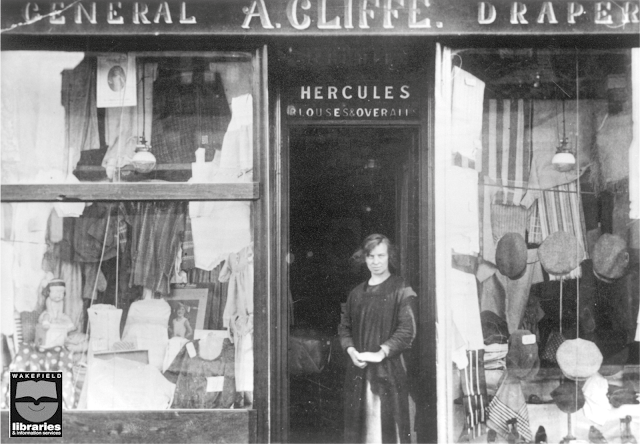Laura, a Public History MA student on placement with us from the University of York, has been exploring the treasures of the ‘Cliffe costume collection’. Read on to discover what they found, and ‘visit’ Miss Cliffe’s Featherstone shop for yourself!
 |
| Miss Annie Cliffe outside her shop, from the early 20th century. Photo copyright of Wakefield Libraries. |
In the early twentieth century Station Lane was a bustling hub of local business and shops. Alongside a newsagents, a greengrocers, and a bookmakers, was a drapers shop, owned by Miss Annie Cliffe. Described as “friendly, kind and considerate”, Miss Cliffe was a pioneering local businesswoman.
In this blog, we’ll explore Miss Cliffe’s story and how the Cliffe Costume Collection now owned by Wakefield Museums & Castles is a treasure chest of practically untouched working-class clothing and accessories.
 |
| A photo of Station Lane, Featherstone, from the early 20th century. Photo copyright of Wakefield Libraries. |
“It was the only place [dad] could get [caps] from”
 |
| A purple blouse, Edwardian-style. Around the neck and front of the blouse there are basting stitches to keep the pleats in place when on display. These stitches would have been easy to remove once the shirt had been purchased. Part of the unsold stock from Cliffe's Drapers now in our collection. Miss Cliffe’s shop is remembered as being “old-fashioned” and “like Aladdin’s cave” in a series of oral histories recorded in the 1990s. The counter on the right was for the many blouses and other items of clothing. The counter facing the door mainly displayed knitting needles, sewing tools and materials for hand-making and mending clothes. Although money may have been
tight for working-class people, shops like Miss Cliffe’s widened accessibility
to the latest fashions. The collection the shop left behind helps show how
fashion in Featherstone developed over the decades. A green-blue Tam O'Shanter hat that was for sale at Cliffe's Drapers. Tam O'Shanters were especially popular during the 1920s and were often worn by young girls and women. They were easy to sew or knit, and relatively cheap to buy. As a result, many young women would make or buy multiple Tam O'Shanters to match with different outfits. “Her own Empire”Establishing the origins of Cliffe’s Drapers has been quite difficult as the relevant documents have been lost. Until now, it wasn’t clear whether Miss Cliffe owned her shop or if she managed it for her parents. However, we can now confidently say that Cliffe’s Drapers was owned and ran by Miss Cliffe. Annie Cliffe was born in Huddersfield on the 29th of March 1880. By the 1911 census she and her family were living at 21 Kimberley Street, Featherstone. In the 1921 census, she is recorded to still be living with her father (Alfred) and sister (Gertrude), who was working as a teacher. Miss Cliffe is recorded as a “Draper shop keeper” and her employer being “her own account” which implies that this was her own business. The 1921 census is also the earliest account so far that we have found that records the shop. The 1927 and 1932 censuses also record Miss Cliffe along with her shop ownership. As an unmarried woman from not a particularly affluent family, the fact that she owned and ran her own shop is pioneering. This would have been very rare in the early twentieth century. Women could own businesses and shops at this time, and around 30% of businesses between 1851 and 1911 record female owners. However, the social norms and inequalities of the time would have made it extremely difficult for a single woman to have her own business. Understandably, Miss Cliffe was very proud of her shop, which an oral history interviewee in the 1990s remembers as “her own Empire”. |
 |
| A
pin striped child’s sailor suit jacket with a Peter Pan collar, belt and white
buttons. An unsold garment from Cliffe's Drapers, dating to the early 20th century. |
If clothes could talk…
An exhibition will be installed later in 2023 at Featherstone Library, bringing some of Miss Cliffe’s shop stock back to the local high street.


My Grandmother would get things for her multitude of kids from Annie's shop and pay for them weekly.My Mam would walk from Pontefract after school every Friday teatime to pay Annie,come rain or shine.This would be the late 30's,early 40's.My Mam was born in 1930.
ReplyDeleteI am sure that my grandparents, probably my grandmother shopped there. They moved to America in 1915 in their early 20's. They both grew up in Wakefield and met while working at Heath Hold Hall in 1913. I loved reading this! Greetings from across the "pond" in Oklahoma, USA!
ReplyDelete